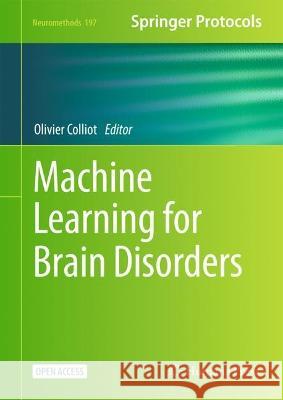Machine Learning for Brain Disorders » książka
Machine Learning for Brain Disorders
ISBN-13: 9781071631942 / Angielski
Machine Learning for Brain Disorders
ISBN-13: 9781071631942 / Angielski
(netto: 185,26 VAT: 5%)
Najniższa cena z 30 dni: 192,74 zł
ok. 20 dni roboczych.
Darmowa dostawa!
This Open Access volume provides readers with an up-to-date and comprehensive guide to both methodological and applicative aspects of machine learning (ML) for brain disorders. The chapters in this book are organized into five parts. Part One presents the fundamentals of ML. Part Two looks at the main types of data used to characterize brain disorders, including clinical assessments, neuroimaging, electro- and magnetoencephalography, genetics and omics data, electronic health records, mobile devices, connected objects and sensors. Part Three covers the core methodologies of ML in brain disorders and the latest techniques used to study them. Part Four is dedicated to validation and datasets, and Part Five discusses applications of ML to various neurological and psychiatric disorders. In theNeuromethodsseries style, chapters include the kind of detail and key advice from the specialists needed to get successful results in your laboratory.Comprehensive and cutting,Machine Learning for Brain Disordersis a valuable resource for researchers and graduate students who are new to this field, as well as experienced researchers who would like to further expand their knowledge in this area. This book will be useful to students and researchers from various backgrounds such as engineers, computer scientists, neurologists, psychiatrists, radiologists, and neuroscientists.
This Open Access volume provides readers with an up-to-date and comprehensive guide to both methodological and applicative aspects of machine learning (ML) for brain disorders. The chapters in this book are organized into five parts. Part One presents the fundamentals of ML. Part Two looks at the main types of data used to characterize brain disorders, including clinical assessments, neuroimaging, electro- and magnetoencephalography, genetics and omics data, electronic health records, mobile devices, connected objects and sensors. Part Three covers the core methodologies of ML in brain disorders and the latest techniques used to study them. Part Four is dedicated to validation and datasets, and Part Five discusses applications of ML to various neurological and psychiatric disorders. In the Neuromethods series style, chapters include the kind of detail and key advice from the specialists needed to get successful results in your laboratory.
Comprehensive and cutting, Machine Learning for Brain Disorders is a valuable resource for researchers and graduate students who are new to this field, as well as experienced researchers who would like to further expand their knowledge in this area. This book will be useful to students and researchers from various backgrounds such as engineers, computer scientists, neurologists, psychiatrists, radiologists, and neuroscientists.











